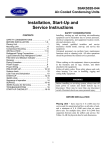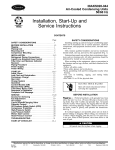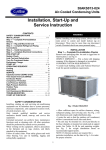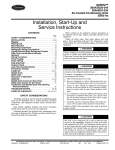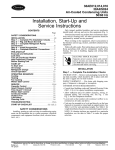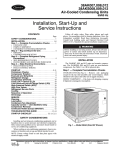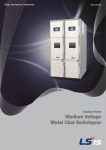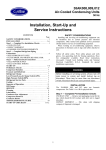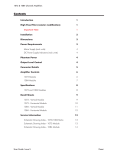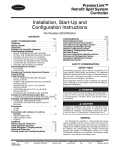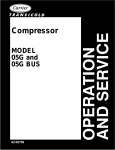Download Carrier 38AD028 Unit installation
Transcript
Concepcion-Carrier Air conditioning Company Philippines CONTENTS 38AKS016 - 044 AIR-COOLED CONDENSING UNITS - 60 Hz INSTALLATION, OPERATING MANUAL & SERVICE INSTRUCTIONS Page Page SAFETY CONSIDERATIONS 2 INSTALLATION Step 1 – Complete Pre-Installation Checks Step 2 – Rig and Mount the Unit Step 3 – Complete Refrigerant Piping Connections Step 4 – Complete Electrical Connections 2 2 2 8 10 PRE-START-UP System Check-up Leak Test and Dehydration Turn on Crankcase Heater Preliminary Charge 12 12 13 13 13 START-UP Preliminary Checks Preliminary Oil Charge Start Unit Adjust Refrigerant Charge 13 13 13 13 14 38AKS016/024 Check Compressor Oil Level Final Checks 14 14 OPERATING SEQUENCE Cooling 14 14 SERVICE Capacity Control Time Guard Circuit Crankcase Heater Compressor Protection High Pressure Switches Low Pressure Switches Outdoor Fans Lubrication Cleaning Coils 20 20 20 20 21 21 21 21 21 21 TROUBLESHOOTING START-UP CHECKLIST 23 25 38AKS028/034 (044 - 3 Fans) SAFETY CONSIDERATIONS • Installing, starting up, and servicing air-conditioning equipment can be hazardous due to system pressures, electrical components, and equipment location (roofs, elevated structures, etc.). Unit may be mounted on a level pad directly on the base channels or mounted on raised pads at support points. See Tables 2A-2B for unit operating weights. See Table 1 for weight distribution based on recommended support points. NOTE: If vibration isolators are required for a particular installation, use the data in Table 1 to make the proper selection. Only trained, qualified installers and service mechanics should install, start-up, and service this equipment (Fig. 1 to Fig. 4). Untrained personnel can perform basic maintenance functions such as cleaning coils. Trained service personnel should perform all other operations. Table 1 - Weight Distribution UNIT 38AKS When working on the equipment, observe precautions in the literature and on tags, stickers, and labels attached to the equipment. 016 024 028 034 044 Follow all safety codes. Wear safety glasses and work gloves. Keep quenching cloth and fire extinguisher nearby when brazing. Use care in handling, rigging, and setting bulky equipment. Total Operating 789 (359) 900 (408) 1650 (748) 1803 (818) 2347 (1105) WEIGHT - lb (kg) Support Point A B C 143 (65) 143 (65) 250 (114) 178 (81) 168 (76) 269 (122) 418 (190) 626 (284) 242 (110) 459 (208) 673 (305) 272 (124) 864 (392) 1077 (488) 221 (100) D 253 (115) 285 (129) 364 (165) 399 (181) 275 (125) ELECTRIC SHOCK HAZARD Separate power sources (main and control power circuits) are used for these units. Be sure both main and control power circuits are disconnected before servicing. 38AKS016 and 024 38AKS028 and 034 INSTALLATION CAUTION Step 1 – Complete Pre-Installation Checks Be sure unit panels are securely in place prior to rigging. UNCRATE UNIT – Remove plastic cover, which should be left in place until after the unit is rigged into its final location. Step 2 – Rig and Mount the Unit INSPECT SHIPMENT – File claim with shipping company if shipment is damaged or incomplete. RIGGING – These units are designed for overhead rigging only. For this purpose, the transverse base channels extend beyond the sides of the unit, with holes provided in the end plates to attach cables or hooks. Rig with top skid packaging assembly in place to prevent unit damage by the rigging cable. As further protection for the coil faces, plywood sheets can be placed against the sides of the unit, behind the cables. Run the cables to a central position point so that the angle from the horizontal is not less than 45 degrees. Raise and set the unit down carefully. CONSIDER SYSTEM REQUIREMENTS • Consult local building codes and National Electrical Code (NEC) for special installation requirements. • Allow sufficient space for airflow clearance, wiring, refrigerant piping, and servicing unit. See Fig. 1 to Fig. 3 for unit component locations. • Locate unit so that outdoor coil (condenser) airflow is unrestricted on all sides and above. 2 3 Fig. 2 – Dimensions (38AKS028/034) 4 Fig. 3 – Dimensions (38AKS044) 5 Table 2A - Physical Data (English, 60 Hz) UNIT 38AKS NOMINAL CAPACITY (tons) 016 15 OPERATING WEIGHT ( lb) REFRIGERANT* Operating Charge, Typical ( lb)** COMPRESSOR Speed (Rpm) 789 No. Cylinders Model No. Oil (pt) Crankcase Heater Watts Unloader Setting (psig) 024 20 900 R-22 23 28 Reciprocating, Semi-Hermetic 1750 6 06DD537 8 125 Load Unload OUTDOOR-AIR FANS No. …Rpm Diameter (in.) Motor Hp Nominal Total Airflow ( Cfm) OUTDOOR COIL Face Area (sq ft) Storage Capacity (lb)^ 70+/-1 60+/-2 Axial Flow, Direct Drive 2 …900 26 1/2 9210 29.2 39.8 39.8 CONTROLS Pressurestat Settings (psig) High Cutout Cut-in Low Cutout Cut-in FUSIBLE PLUG (F) PIPING CONNECTIONS (in. ODM) Suction Liquid 4 06E--50 14 395+/-10 295+/-10 29+/-4 60 +15/-0 200 1 3/8 1 5/8 5/8 *Unit is factory supplied with holding charge only. **With 25 ft of interconnecting piping. Operating charge is approximate for maximum system capacity. ^Storage capacity is measured at liquid saturated temperatures of 130 F for 38AKS016 and 024. 6 Table 2B - Physical Data (English, 60 Hz) UNIT 38AKS 028 034 044 NOMINAL CAPACITY (tons) 25 30 40 OPERATING WEIGHTS (lb) 1650 1803 2437 COMPRESSOR Reciprocating, Semi-Hermetic Model 06E-265 06E-275 Oil (pt) 19 No. Cylinders (ea)…Speed (rpm) 06E-299 19 6… 1750 Capacity Steps 100%, 66% Unloader Setting (psig) No. 1 Load 76 Unload 58 REFRIGERANT R-22 Operating Charge, Typical (lb) 30.5 43.5 CONDENSER FANS 65 Propeller Type - Direct Drive Quantity…Diameter (in.) 2…30 3…30 Nominal Airflow (cfm) 15,700 23,700 Speed (rpm) 1140 Power Consumption (Watts, each) 1492 CONDENSER COIL Enhanced Copper Tubes, Lanced Aluminum Fins Rows…Fins/in. 3… 17 Total Face Area (sq ft) 39.2 58.4 Coil Storage Cap. (lb) - 80% Full at 125 F 56.6 84.4 ELECTRIC CONTROLS Time Guard Device HIGH PRESSURE SWITCH (psig) Cutout 364 +/-7 Cut-in 200 +/-20 LOW PRESSURE SWITCH (psig) Cutout 29 +/-3 Cut-in 44+/-5 OIL PRESSURE SWITCH (psig) Close on Rise 7.0 Open on Fall 5.0 PRESSURE RELIEF Fusible Plug PIPING CONNECTIONS Suction - in. OD 1 5/8 Liquid - in. OD 7/8 Hot Gas Stub - in. OD 5/8 7 If it is necessary to roll the unit into position, mount the unit on longitudinal rails, using a minimum of 3 rollers. Apply force to the rails, not the unit. If the unit is to be skidded into position, place it on a large pad and drag it by the pad. Do not apply any force to the unit. Hot gas bypass, if used, should be introduced before the evaporator. Note that refrigerant suction piping should be insulated. Table 3A - Liquid Line Data Raise from above to lift unit from the rails or pad when unit is in final position. MAXIMUM ALLOWABLE COMPRESSOR MOUNTING – As shipped, the compressor is held tightly in place by self-locking bolts. Before starting unit, loosen self-locking bolts until the snubber washer can be moved sideways with the finger pressure. Do not remove shipping bolts. See Fig. 4. LIQUID LINE LIQUID LIFT UNIT 38AKS ft (m) 60 Hz Maximum Maximum Allowable Allowable Filter Drier and Sight Glass Pressure Drop Temp. Loss Flare Conn. * psig (kPa) F (C) in. (mm) 016 82 (25) 7 (48.3) 2 (1.1) 5/8 024 87 (26.5) 7 (48.3) 2 (1.1) 5/8 *Inlet and outlet NOTE: Data shown is for units operating at 45 F (7.2 C) saturated suction and 95 F (35 C) entering air. Table 3B - Maximum Liquid Lift (028/034/044) Fig. 4 – Compressor Mounting Step 3 – Complete Refrigerant Piping Connections IMPORTANT: A refrigerant receiver is not provided with the unit. Do not install a receiver. SIZE REFRIGERANT LINES – Consider the length of piping required between outdoor unit and indoor unit (evaporator), the amount of liquid lift, and compressor oil return. See Tables 3A4B for design details and line sizing. Refer to indoor unit installation instructions for additional information. NOTE: Use the piping data in Tables 3A-4B as a general guide only. 8 UNIT 38AKS FT 028 034 044 76 67 76 Table 4A - Refrigerant Piping Sizes 0-15 (0-4.5) UNIT 38AKS 016 024 L 1/2 5/8 S 1 3/8 1 5/8 LENGTH OF INTERCONNECTING PIPING, FT (M) 15-25 25-50 50-75 (4.5-7.5) (7.5-15) (15-23) Line Size (in. OD) L S L S L S 5/8 1 3/8 5/8 1 5/8 7/8 1 5/8 5/8 1 5/8 7/8 1 5/8 7/8 2 1/8 75-100 (23-30) L 7/8 7/8 S 2 1/8 2 1/8 LEGEND L - Liquid S - Suction Close-coupled. NOTES: 1. Pipe sizes are based on a 2 F (1.1 C) loss for liquid lines and a 1.5 F (0.8 C) loss for suction lines. 2. Pipe sizes are based on an equivalent length equal to the maximum length of interconnecting piping plus 50% for fittings. A more accurate estimate may result in smaller sizes. 3. Line size conversion to mm: in. mm. 1/2 12.7 5/8 15.9 7/8 22.2 1 1/8 28.6 1 3/8 34.9 1 5/8 41.3 2 1/8 54 Table 4B - Refrigerant Piping Sizes SINGLE SUCTION RISERS UNIT 38AKS 028 L 7/8 S 1 5/8 LENGTH OF INTERCONNECTING PIPING, FT 26-50 51-75 76-100 L S L S L S 7/8 1 5/8 7/8 2 1/8 7/8 2 1/8 034 044 7/8 7/8 1 5/8 1 5/8 7/8 7/8 16-25 1 5/8 1 5/8 7/8 7/8 LEGEND L - Liquid Line S - Suction Line NOTE: Liquid and suction line sizes are OD (in.) 9 2 1/8 2 1/8 1 1/8 1 1/8 2 1/8 2 1/8 101-200 L S 7/8 2 1/8 1 1/8 1 1/8 2 5/8 2 5/8 INSTALL FILTER DRIER(S), MOISTURE INDICATOR(S) AND SOLENOID VALVE(S) – The illustrations below are the standard piping connections. INSTALL LIQUID LINE SOLENOID VALVE – CAPACITY CONTROL - For 2-step cooling , place a solenoid valve in the location shown in Fig. 5 and Fig. 6 , upper circuit (ckt. 2). Circuit (ckt.) 2 shall be controlled by Thermostat 2 (T2). Complete the refrigerant piping from indoor unit to outdoor unit before opening the liquid and suction lines at the outdoor unit. MAKE PIPING CONNECTIONS – Do not remove runaround loop from suction and liquid line stubs in the compressor compartment until piping connections are ready to be made. Pass nitrogen or other inert gas through piping while brazing to prevent formation of copper oxide. FOR 38 AKS 016/024 WARNING Recover holding charge prior to removal of runaround piping loop (R-22). FOR 38AKS 024 ONLY 1. Open service valves: a. Discharge service valve on compressor. b. Suction service valve on compressor. c. Liquid line valve. 2. Remove ¼ in. flare cap from liquid valve Schrader port. 3. Attach refrigerant recovery device and recover holding charge. 4.Remove runaround loop. Fig. 5– Location of Sight Glass, Filter Drier and Solenoid Valve(s) for 38 AKS 016/024 5. Install the field-supplied filter drier(s), liquid moisture indicator(s)and solenoid valve(s) in the piping based on the given illustrations. PROVIDE SAFETY RELIEF – A fusible plug is located on the compressor crankcase or in the liquid line (Fig.7). Do not cap this plug. Step 4 – Complete Electrical Connections POWER WIRING – Unit is factory wired for voltage shown on nameplate. Provide adequate fused disconnect switch within sight from unit and readily accessible from unit, but out of the reach of children. Lock switch open (off) to prevent power from being turned on while unit is being serviced. Disconnect switch, fuses, and field wiring must comply with national and local code requirements. See Tables 5A and 5B. Fig. 6 – Location of Sight Glasses, Filter Driers and Solenoid Valves for 38AKS 028/034/044 10 NOTE: 38AKS024, 034 & 044 has a fusible plug in the liquid line. Fig. 8 – Main power Supply Wiring Fig. 7 – Location of Fusible Plug (38AKS) Table 5A - Electrical Data (3 Ph/60 Hz) UNIT UNIT 38AKS 016 024 COMPR Volts Model 501 601 501 601 Nameplate 208-230 460 208-230 460 Supplied* Min Max 187 253 414 528 187 253 414 528 MCA ICF MOCP C.B. 87.5 40.7 93.4 48.1 274 124 353 177 125 60 150 80 LEGEND RLA LRA 63.6 29.3 67.9 34.7 266 120 345 173 FAN MOTORS (Single Phase) FLA(ea) Total Fan No. HP Fans 1 2 3.6 2 1/2 1.8 3.6 2 1/2 1.8 *Units are suitable for use on electrical systems where voltage supplied to the unit terminals is not below or above the listed limits. NOTES: 1. The MCA and MOCP values are calculated in accordance with the National Electrical Code (NEC) article 440 (U.S.A. standard). 2. Motor RLA and LRA values are established in accordance with Underwriters' Laboratories (UL) Standard 1995 (U.S.A. standard). FLA - Full Load Amps (Fan Motors) ICF - Maximum Instantaneous Current Flow during start-up (LRA of compressor plus total FLA of fan motors) kW - Total Fan Motor Input (kilowatts) LRA - Locked Rotor Amps MCA - Minimum Circuit Amps per NEC (U.S.A.), Section 430-24 MOCP- Maximum Overcurrent Protection (amps) RLA - Rated Load Amps (Compressor) CB - Circuit Breaker (Amps) 11 Table 5B - Electrical Data (3 Ph/60 Hz) UNIT 38AKS 028 034 044 FLA ICF - LRA MCA - Nominal Voltage UNIT Voltage Range* Min Max 208-230 460 208-230 460 208-230 460 187 414 187 414 187 414 254 508 254 508 254 508 COMPRESSOR FAN MOTORS FLA RLA LRA Qty 102.2 49.8 118.4 56.2 165.6 74.7 89.8 43.6 106.5 50 147.5 65.4 446 223 506 253 690 345 LEGEND Full Load Amps Maximum Instantaneous Current Flow during starting. (The point in the starting sequence where the sum of the LRA for the starting compressor, plus the total RLA for all running compressors, plus the total FLA for all running motors is maximum). Locked Rotor Amps Minimum Circuit Amps 3 MOCP OFM RLA C.B. - FLA (ea) MCA ICF MOCP (C.B.) 5.5 2.75 5.5 2.75 5.5 2.75 124.6 60.7 145.5 68.7 203 91 452.2 226.1 512.2 256.1 702.4 351.2 200 100 250 110 350 150 Maximum Overcurrent Protection Outdoor (Condenser) Fan Motor Rated Load Amps Circuit Breaker (Amps) *Units are suitable for use on electrical systems where voltage supplied to the unit terminals is not below or above the listed minimum and maximum limits. Route power wires through opening in unit end panel to connection in unit control box as shown on unit label diagram and in Fig. 8. Unit must be grounded. If unit has field-installed accessories, be sure all are properly installed and correctly wired. If used, airflow switch must be properly installed. Affix crankcase heater warning sticker to unit disconnect switch. See accessories with unit. 2. Backseat (open) compressor suction and discharge valves. Now close valves one turn to allow refrigerant pressure to reach test gages. PRE-START-UP 3. Open liquid line service valve. IMPORTANT: Before beginning Pre-Start-up or Startup, review Start-Up Checklist at the back of this book. The Checklist assures proper start-up of a unit and provides a record of unit condition, application requirements, system information, and operation at initial start-up. 4. Check tightness of all electrical connections. CAUTION Do not attempt to start the condensing unit, even momentarily, until the following steps have been completed. Compressor damage may result. 5. Compressor oil level should be visible in sight glass. See Fig. 9. Adjust the oil level as required. Refer to Preliminary Oil Charge section. No oil should be removed unless the crankcase heater has been energized for at least 24 hours. 6. Be sure unit is properly leak checked, dehydrated, and charged. See Preliminary Charge. 7. Electrical power source must agree with nameplate rating. 8. Crankcase heater must be firmly locked into compressor crankcase. Be sure crankcase is warm (heater must be on for 24 hours before starting compressor). 9. Be sure compressor floats freely on the mounting springs and that snubber washers can be moved with finger pressure. See Compressor Mounting, page 9, and Fig. 5 for loosening compressor bolts. System Check 1. 2 POWER SUPPLY Check all air handler(s) and other equipment auxiliary components. Consult the manufacturer’s instructions regarding any other equipment connected to the condensing unit. 12 Leak Test and Dehydration – Leak test the entire refrigerant system using soap bubbles and/or an electronic leak detector. section, Leak Test and Dehydration. 9. All internal wiring connections must be re-tightened, and all barriers and covers must be in place. Turn On Crankcase Heater – Turn on crankcase heater for 24 hours before starting the unit to be sure all the refrigerant is out of the oil. To energize the crankcase heater, proceed as follows: Preliminary Oil Charge – Compressor is factory charged with oil (see Tables 2A-2B). When oil is checked at start-up, it may be necessary to add or remove oil to bring it to the proper level. One recommended oil level adjustment method follows: 1. Set the space thermostat set point above the space temperature so there is no demand for cooling. 2. Close the field disconnect. ADD OIL – Close suction service valve and pump down crankcase to 2 psig (14 kPag). (Low-pressure switch must be jumpered). Wait a few minutes and repeat until pressure remains steady at 2 psig (14 kPag). Remove oil fill plug above the oil level sight glass, add oil through plug hole, and replace plug. Run compressor for 20 minutes and check oil level. See Fig. 9. 3. Turn the fan circuit breaker on. Leave the compressor circuit breakers off. The crankcase heater is now energized Preliminary Charge – Charge each system with R-22 by the liquid charging method (through liquid service valve) on the high side when the system has not yet been started. Charge according to the values in the Charging Chart, Fig. 10 to 14 via the suction service valve when the system has started. NOTE: Use only Carrier approved compressor oil. Approved sources are: Totaline. ……………………………………150 SUS Texas, Inc. ………………………………...Capella WF-32 Witco Chemical Co. ………………………Suniso 3GS START-UP Do not use oil that has been drained out, or oil that has been exposed to atmosphere, due to moisture content. Compressor crankcase heater must be on 24 hours before start-up. After the heater has been on for 24 hours, the unit can be started. However, if start-up is done immediately after charging, the 24 hours wait is NOT necessary. REMOVE OIL – Pump down compressor to 2 psig (14 kPag). Loosen the ¼ in. (6.4 mm) pipe plug at the compressor base and allow the oil to seep out past the threads of the plug. Preliminary Checks 1. Ensure that compressor service valves are back seated. NOTE: The crankcase will be slightly pressurized. Do not remove the plug, or the entire oil charge will be lost. 2. Verify that each compressor floats freely on its mounting springs, snug fit on washer. Small amounts of oil can be removed through the oil pump discharge connection while the compressor is running. 3. Check that electric power supply agrees with the unit nameplate data. 4. Verify that compressor crankcase heater is securely in place. 5. Check that compressor crankcase heater has been on at least 24 hours. 6. Note that compressor oil level is visible in the sight glass. Next, close the compressor circuit breaker and then reset space thermostat below ambient so that a call for cooling is ensured. If compressor does not start, set thermostat lower. 7. Recheck for leaks using same procedure as previously outlined in Pre-Start-Up section, Leak Test and Dehydration. NOTE: Do not use circuit breaker to start and stop the compressor except in an emergency. 8. If any leaks are detected, evacuate, repair and dehydrate as previously outlined in Pre-Start-Up Start Unit – The field disconnect is closed, the fan circuit breaker is closed, and the space thermostat is set above ambient so that there is no demand for cooling. Only the crankcase heater will be energized. 13 If the initial check shows too much oil (too high in the sight glass) remove oil to proper level. See Preliminary Oil Charge, for proper procedure for adding and removing oil. See Fig. 9. CAUTION Never charge liquid into the low-pressure side of system. Do not overcharge. During charging or removal of refrigerant, be sure indoor-fan system is operating. When the above checks are complete, repeat the procedure with the unit operating at minimum load conditions. Adjust Refrigerant Charge MAX. 3/4 OF SIGHT GLASS NOTE: Actual start-up and all refrigerant charge modifications should be done only under supervision of a qualified refrigerant mechanic. 1/8 OF SIGHT GLASS With all fans operating, adjust the refrigerant charge. MIN. 1/4 OF SIGHT GLASS 3/8 OR 1/3 OF SIGHT GLASS Measure pressure at the liquid line service valve, being sure Schrader depressor is used if required. Also, measure liquid line temperature as close to the liquid service valve as possible. Add charge until the pressure and temperature conditions of the charging chart curve are met. If liquid pressure and temperature point fall above curve, add charge. If liquid pressure and temperature point fall below curve, reduce the charge until the conditions match the curve. (± 3 ºF allowable range) 38AKS024 – 044 (06E COMPRESSOR) 38AKS016 (06D COMPRESSOR) Fig. 9 – Operating Oil Levels Final Checks – Ensure all safety controls are operating, control panel covers are on, and the service panels are in place. If the sight glass is cloudy, check refrigerant charge again. Ensure all fans are operating. Also ensure maximum allowable liquid lift has not been exceeded. If charge per chart and if the sight glass is still cloudy, check for a plugged filter drier or a partially closed solenoid valve. Replace or repair, as needed. OPERATING SEQUENCE Cooling - When the first stage (TC1) of the cooling thermostat closes, timer starts. After 3 minutes, the timer expires, energizing the compressor. Check Compressor Oil Level – After adjusting the refrigerant charge, allow the compressor to run fully loaded for 20 minutes. Running oil level should be within view of the crankcase sight glass. Stop the compressor at the field power supply disconnect and check the crankcase oil level. Add oil only if necessary to bring the oil into view in the sight glass. If oil is added, run the compressor for an additional 10 minutes; then stop and check oil level. If the level remains low, check the piping system for proper design for oil return; also, check the system for leaks. On demand for additional cooling capacity, the second stage (TC2) of the cooling thermostat closes, energizing field supplied liquid line solenoid (LLS) valve, which opens. At shutdown, the Time Guard timer prevents the compressor from re-starting for approximately 3 minutes. 14 15 FIG. 10 – 38AKS016 CHARGING CHART 16 FIG. 11 – 38AKS024 CHARGING CHART 17 FIG. 12 – 38AKS028 CHARGING CHART 18 FIG. 13 – 38AKS034 CHARGING CHART 19 FIG. 14 – 38AKS044 CHARGING CHART When installed, a field supplied solenoid shuts of the liquid line to prevent refrigerant migration back to the compressor during the off cycle. SERVICE Capacity Control – For compressors equipped with an unloader, 2 cylinders are unloaded to provide capacity control. The unloader maybe suction-pressure actuated or electrically operated. Suction pressure-actuated unloader as shown in Fig 15, is controlled by suction pressure that automatically unloads when system load is low and loads up when system load increases. Factory setting is 10 turns from bottom stop (CCW) before R-22 charging (control set point) (see Tables 2A-2B). CONTROL SET POINT (cylinder load point) is adjustable from 0 to 85 psig (586 kPa). To adjust, turn control set point adjustment nut (Fig. 15) clockwise to its bottom stop. In this position, set point is 85 psig (586 kPa). Next, turn adjustment counterclockwise to desired control set point. Every full turn counterclockwise decreases set point by 7.5 psig (51.7 kPa). For 38AKS016 & 024: 2 turns CCW. For 38AKS028, 034 & 044: 1 ½ turns CCW. Fig. 15 – Suction Pressure Unloader Electric unloader as shown in Figure 16, needs an electric solenoid coil wired in the control circuit, usually controlled by the thermostat. Time Guard Circuit – Circuit prevents short cycling by providing a delay of 3 minutes before restarting compressor after shutdown from safety device action. On start-up, the Time Guard timer causes a delay of approximately 3 minutes seconds after thermostat closes. Refer to label diagram of the unit. Crankcase Heater – The heater prevents refrigerant migration and compressor oil dilution during shutdown whenever compressor is not operating. It is wired to cycle with the compressor; the heater is off when compressor is running, and on when compressor is off. Both compressor service valves must be closed (front seated) whenever the crankcase heater is de-energized for more than 6 hours. The crankcase heater is operable as long as the control circuit is energized. Fig. 16 – Electric Solenoid Coil Unloader 20 COMPRESSOR OVERTEMPERATURE PROTECTION (IP) – A thermostat installed in compressor motor winding reacts to excessively high winding temperatures and shuts off the compressor. (This is applicable only for 06D Compressor, not on 06E.) Discharge Temp. Sensor is on Cylinder Head for 06E, externally. COMPRESSOR has its own oil supply. Loss of oil due to a leak in the system should be the only reason for adding oil after the system has been in operation. See Preliminary Oil Charge section. Cleaning Coils – The coils can be cleaned with a vacuum cleaner, washed out with water, blown out with low pressure compressed air, or brushed (do not use wire brush). Fan motors are drip-proof but not waterproof. Therefore wrap motors in plastic bags, to be sure. TIME GUARD CONTROL – Control prevents compressor from short cycling. See Operating Sequence. CRANKCASE HEATER – Heater minimizes absorption of liquid refrigerant by oil in crankcase during brief or extended shutdown periods. The control circuit is maintained if compressor fan motor circuit breakers are turned off. The main disconnect must be on to energize crankcase heater. Clean outdoor coil annually or as required by location or outdoor air conditions. Inspect coil monthly, and clean as required. For 38AKS016 AND 024 fins are not continuous through coil sections; dirt and debris may pass through first section, become trapped between 3 rows of fins and restrict outdoor airflow. Use a flashlight to determine if dirt or debris has collected between coil sections. Cleaning coil of 38AKS028 to 044 is not as hard as cleaning the coil of 38AKS016 and 024 because it has a continuous coil section (3 rows). Clean coil as follows: IMPORTANT: Never open any switch or disconnect that energizes the crankcase heater unless unit is being serviced or is to be shutdown for a prolonged period. After a prolonged shutdown on a service job, energize the crankcase heater for 24 hours before starting the compressor. 1. Turn of unit power. 2. Remove screws holding rear corner posts and top cover in place. Pivot top cover up 12 to 18 in. (305 to 457 mm) and support with a rigid support. See Fig. 18. 3. Remove clips securing tube sheets together at the return bend end of the coil. Carefully spread the ends of the coil rows apart by moving the outer sections. See Fig. 19. 4. Using a water hose, or other suitable equipment, flush down between the sections of coil to remove dirt and debris. 5. Clean the remaining surfaces in the normal manner. 6. Reposition outer coil sections. 7. Reinstall clips which secure tube sheets. 8. Replace top cover and rear corner posts. High Pressure Switches – Switches have fixed, nonadjustable settings. Switches are mounted on the compressors. Low Pressure Switches – Switches have fixed, nonadjustable settings. Switches are mounted on the compressors. TO CHECK – Slowly close liquid shutoff valve and allow compressor to pump down. Do not allow compressor pumpdown below 2 psig (13.8 kPa). Compressor should shut down when suction pressure drops to cutout pressure in Tables 2A2B, and should restart when pressure builds up to cut-in pressure shown. Outdoor Fans – Each fan is supported by a formed wire mount bolted to the fan deck and covered with a wire guard. The exposed end of the motor shaft is covered with sealing gum. In case a fan motor must be repaired or replaced, be sure to put a new sealing gum when the fan is reinstalled and be sure the fan guard is in place before starting the unit. Fig. 17 shows the proper position of the mounted fan. Fan motors have permanently lubricated bearings. Lubrication FAN MOTORS have sealed bearings. No provisions are made for lubrication. 21 Fig. 17 – Outdoor Fan – 38AKS016 & 024 Fig. 18 – Pivot and Support Top Cover – 38AKS016 & 024 Fig. 19 – Coil Cleaning Typical – 38AKS016 & 024 22 TROUBLESHOOTING PROBLEM SOLUTION COMPRESSOR DOES NOT RUN Contactor Open 1. Power off. 1. Restore power. 2. Fuses blown in field power circuit. 2. After finding cause and correcting, replace with correct size fuse. 3. No control power. 3. Check control circuit breaker; reset if tripped or replace if defective. 4. Thermostat circuit open. 4. Check thermostat setting. 5. Time Guard II device not operating. 5. Check Time Guard II devices. 6. Compressor circuit breaker tripped. 6. Check for excessive compressor current draw. Reset breaker; replace if defective. 7. Safety device lock-out circuit active. 7. Reset lock-out circuit at thermostat or circuit breaker. 8. Low-pressure switch open. 8. Check for refrigerant undercharge, obstruction of indoor airflow, or whether compressor suction shutoff valve is fully open. Make sure liquid line solenoid valve(s) is open. 9. High-pressure switch open. 9. Check for refrigerant overcharge, obstruction or outdoor airflow, air in system, or whether compressor discharge valve is fully open. Be sure outdoor fans are operating correctly. 10. Compressor overtemperature switch open. 10. Check for open condition. Allow for reset. Replace if defective. 11. Loose electrical connections. 11. Tighten all connections. 12. Compressor stuck. 12. See compressor service literature. Contactor Closed 1. Compressor leads loose. 1. Check connections and tighten. 2. Motor windings open. 2. See compressor service literature. 3. Single phasing. 3. Check for blown fuse. Check for loose connection at compressor terminal. Contact power company. COMPRESSOR STOPS ON HIGH PRESSURE SWITCH Outdoor Fan On 1. High-pressure switch faulty. 1. Replace switch. 2. Reversed fan rotation. 2. Confirm rotation, correct if necessary. 3. Airflow restricted. 3. Remove obstruction. 4. Air re-circulating. 4. Clear airflow area. 5. Noncondensables in system. 5. Recover refrigerant and recharge as required. 6. Refrigerant overcharge. 6. Recover refrigerant as required. 7. Line voltage incorrect. 7. Consult power company. 8. Refrigerant system restrictions. 8. Check or replace filter drier, expansion valve, etc. Check that compressor discharge service valve is fully open. Outdoor Fan Off 1. Fan slips on shaft. 1. Tighten fan hub setscrews. 2. Motor not running. 2. Check power and capacitor. 3. Motor bearings stuck. 3. Replace bearings. 4. Motor overload open. 4. Check overload rating. Check for fan blade obstruction. 5. Motor burned out. 5. Replace motor. COMPRESSOR CYCLES ON LOW PRESSURE SWITCH Indoor-Air Fan Running 1. Compressor suction service valve partially closed. 1. Open valve fully. 2. Liquid line solenoid valve(s) fails to open. 2. Check liquid line solenoid valve(s) for proper operation. Replace if 3. Filter drier plugged. 3. Replace filter drier. 4. Expansion valve power head defective. 4. Replace power head. 5. Low refrigerant charge. 5. Add charge. Check low-pressure switch setting. Check system for leaks. necessary. 23 TROUBLESHOOTING (cont) PROBLEM COMPRESSOR CYCLES ON LOW PRESSURE SWITCH Airflow Restricted 1. Coil iced up. 2. Coil dirty. 3. Air filters dirty. 4. Dampers closed. Indoor-Air Fan Stopped 1. Electrical connections loose. 2. Fan relay defective. 3. Motor overload open. 4. Motor defective. 5. Fan belt broken or slipping. SOLUTION 1. Check refrigerant charge. 2. Clean coil fins. 3. Clean or replace filters. 4. Check damper operation and position. 1. Tighten all connections. 2. Replace relay. 3. Power supply. 4. Replace motor. 5. Replace or tighten belt. COMPRESSOR RUNNING BUT COOLING INSUFFICIENT Suction Pressure Low 1. Refrigerant charge low. 2. Head pressure low. 3. Air filters dirty. 4. Expansion valve power head defective. 5. Indoor coil partially iced. 6. Indoor airflow restricted. Suction Pressure High 1. Unloaders not functioning. 2. Compressor valve defective. 3. Heat load excessive. 1. Check unloader adjustments. Check unloader setting. 2. See compressor service literature. 3. Check for open doors or windows in vicinity of fan coil. UNIT OPERATES TOO LONG OR CONTINUOUSLY. 1. Low refrigerant charge. 2. Control contacts fused. 3. Air in system. 4. Partially plugged expansion valve or filter drier. 1. Add refrigerant. 2. Replace control. 3. Purge and evacuate system. 4. Clean or replace. SYSTEM IS NOISY 1. Piping vibration. 2. Compressor noisy. 1. Add refrigerant. Check system for leaks and fix. 2. Check refrigerant charge. Check outdoor-air fan thermostat settings. 3. Clean or replace filters. 4. Replace power head. 5. Check low pressure setting. 6. Remove obstruction. 1. Support piping as required. 2. Check valve plates for valve noise. Re-pipe compressor if bearings are worn. COMPRESSOR LOSES OIL 1. Leak in system. 2. Crankcase heaters not energized during shutdown. 3. Improper interconnecting piping design. 1. Repair leak. 2. Check wiring and delays. Check heater and replace if defective. 3. Check piping for oil return. Replace if necessary. FROSTED SUCTION LINE Expansion valve admitting excess refrigerant. Adjust expansion valve. HOT LIQUID LINE 1. Shortage of refrigerant due to leak. 2. Expansion valve opens too wide. 1. Repair leak and recharge. 2. Adjust expansion valve. FROSTED LIQUID LINE 1. Restricted filter drier. 2. Liquid line solenoid partially closed. 1. Remove restriction or replace. 2. Replace valve. COMPRESSOR WILL NOT UNLOAD 1. Defective unloader. 2. Defective capacity control solenoid valve (if used). 3. Miswired capacity control liquid line solenoid (if used). 4. Weak, broken, or wrong valve body spring. 1. Replace unloader. 2. Replace valve. 3. Rewire correctly. 4. Replace spring. COMPRESSOR WILL NOT LOAD. 1. Miswired capacity control liquid line solenoid (if used). 2. Defective capacity control solenoid valve (if used). 3. Plugged strainer (high side). 4. Stuck or damaged unloader piston or piston ring(s). 1. Rewire correctly. 2. Replace valve. 3. Clean or replace strainer. 4. Clean or replace the necessary parts. 24 25 START-UP CHECKLIST FOR 38AKS CONDENSING UNIT (MUST BE SENT TO CCAC UPON COMPLETION) A. PRELIMINARY INFORMATION Job Name : Location : Installing Contractor : Distributor : Start-up performed by : Start-up Date : EQUIPMENT: Model : Serial No. : COMPRESSOR: Model : Serial No. : Motor No. : Volts : INDOOR UNIT: B. RLA : Manufacturer : Model : Serial No. : Volts : RLA/KW : PRELIMINARY EQUIPMENT CHECK (Yes or No) Is there any shipping damage? If so, where? Will this damage prevent unit start-up? Check power supply. Does it agree with unit? Has the circuit protection been sized and installed properly? Are the supply wires sized as per requirement? Are the refrigerant lines sized as per requirement? Have the electrical components been checked for tightness? Check Air Systems (Yes or No) Is air handler operational? Correct rotation? V-belts tension normal? Record motor amperage L1 A, L2 A, L3 A Check for possible leak caused by shipment Leak check thoroughly compressor, fusible plugs, thermostatic expansion valve (TXV), filter drier and other parts with electronic leak detector of soap bubbles. Check voltage imbalance AB . V, AB + AC + BC (divided by 3) = AVERAGE VOLTAGE = 25 AC V, BC V V MAXIMUM DEVIATION FROM AVERAGE VOLTAGE = VOLTAGE IMBALANCE = (Max. deviation) x 100 = Average Voltage V %VOLTAGE IMBALANCE If over 2% Voltage Imbalance, do not attempt to start the unit! Call local power company for assistance. Assure that incoming power supply voltage to unit is within the range of PLUS or MINUS 10% rated voltage. C. UNIT START-UP (insert check mark as each item is completed) q Ensure crankcase heaters have been energized for a minimum of 24 hours prior to start-up. q Ensure compressor oil level is correct. q Ensure liquid line service valve is backseated. q Ensure compressor suction service valve is backseated. q Ensure compressor discharge service valve is backseated. q Loosen compressor shipping holddown bolts. § Check operation of the following: q Crankcase Heater. q Time Guard II Control. q Head Pressure Control. q Capacity Control. q Low Pressure Switch Control. q Oil Pressure Switch (for AKS024, AKS028, AKS034 & AKS044 only) q Be sure temperature controller is set properly. q Set point should be adjusted to the desired room/space temperature. § Does machine start at first attempt? If not, explain why § Measure the following while machine is in stable operation. Suction Pressure / Saturated Temperature °F PSIG °F °F Discharge Line Temperature °F Liquid Line Pressure / Saturated Temperature °F Liquid Line Temperature Liquid Subcooling PSIG °F Discharge Pressure / Saturated Temperature Discharge Superheat °F °F Suction Line Temperature Suction Superheat PSIG °F 26 § Record motor amperage Compressor L1 A, Fan Motor 1 A 2 A L2 A, L3 A Remarks / Comments: Signature Technician Date Signature Customer 27 Date




























